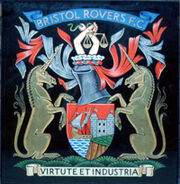
club badge the one and only.
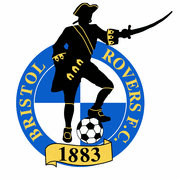
The current logo of Bristol Rovers F.C.
The history of Bristol Rovers began over 140 years ago, in 1883. In that time the club has enjoyed limited success on the field and a turbulent, at times, history off of it. Bristol Rovers have enjoyed success, endured failure, been embroiled in corruption scandals and faced homelessness on more than one occasion.
| Contents |
|---|
|
Formation * 1880s * 1890s * 1900s * 1910s * 1920s * 1930s * 1940s * 1950s * 1960s * 1970s * 1980s * 1990s * 2000s |
Formation[]
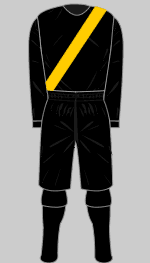
Bristol Rovers team kit for the 1883-84 season. Copyright Historical Football Kits and reproduced by kind permission.
The club was formed in September 1883, following a meeting in the Eastville Restaurant in Queen's Parade, Stapleton Road, Bristol, organised by a 19-year-old schoolteacher called Bill Somerton. They later took the name Black Arabs F.C., so called because of their predominantly black kit and the fact that they played on an adjoining pitch to the Arabs rugby team, at Purdown.
On 1 December 1883 the Black Arabs played their first match, a friendly match against Gloucestershire side Wotton-under-Edge, which ended in a 6-0 defeat. As well as two games against Wotton, the Black Arabs also played Warmley, Bristol Wagon Works and Right & Might in a total of ten matches over the course of their first season. The team acquired the nickname The Purdown Poachers, after the area where they played.
The 1880s[]
In 1884, one year after formation, the club changed its name to Eastville Rovers, after the Eastville area of Bristol, in an effort to draw more players and interest from the local area. The team moved from Purdown for the 1884-85 season and played their home games at a field called Three Acres, the precise location of which is not known today.
The team continued to play friendly matches for the rest of the decade, and in the 1887-88 season took part in the inaugural Gloucestershire Cup, their first taste of competitive action, suffering a 4-1 defeat to Clifton. In 1888-89 Eastville Rovers won their first trophy, beating Warmley 1-0 in the final of the Gloucestershire Cup.
Honours
- Gloucestershire Cup - 1888-89
The 1890s[]
| Season | League | Position |
|---|---|---|
| 1892-93 | Bristol & District League | 6th of 9 teams |
| 1893-94 | Bristol & District League | 11th of 12 |
| 1894-95 | Bristol & District League | 6th of 12 |
| 1895-96 | Western League Division 1 | =2nd of 11 |
| 1896-97 | Western League Division 1 | 5th of 9 |
| Bristol Eastville Rovers league record | ||
| 1897-98 | Birmingham & District League | 3rd of 16 |
| Western League Professional Section | 5th of 8 | |
| Bristol Rovers league record | ||
| 1898-99 | Birmingham & District League | 4th of 18 |
| Western League Professional Section | 4th of 5 | |
The decade began with Eastville Rovers continuing to mainly play friendly matches, as well as taking part in the Gloucestershire Cup each year. In 1890, Rovers again reached the final of this competition, losing 7-2 to Clifton Association in a game that was notable for the fact that the referee was England cricketer W. G. Grace.
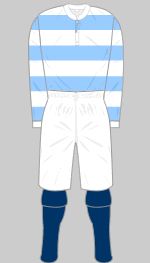
Bristol Rovers team kit for the 1897-98 season. Copyright Historical Football Kits and reproduced by kind permission.
In May 1891 the club negotiated a deal to allow them to play at the Schoolmasters Cricket Ground, Horfield for the 1891-92 season. Rovers only played there for one season however, and moved to Durdham Down for 1892-93 season.
1892 was a major landmark in the history of the club, with Eastville Rovers joining an organised league for the first time. Rovers became a founding member of the Bristol & District League (later to become the Western League), and their first league game was played on 1 October 1892 against Mangotsfield F.C.. Although it was officially a home game for Rovers, the game was played at Mangotsfield and Rovers were defeated by 3 goals to 1. This first season ended with Rovers placed sixth of the nine teams in the league, with six wins, two draws and eight defeats from the sixteen games played.
The 1893-94 season was a poor one, with Rovers finishing 11th out of 12 teams, with only Mangotsfield F.C. below them in the league. Things improved in 1894-95 however with a 6th place finish. This season saw Rovers move to their fifth home, locating themselves at a ground referred to sometimes as Rudgeway and at other times as Ridgeway in the Fishponds area of the city. On 22 September 1894 the first meeting of the two teams that went on to become Bristol Rovers and Bristol City took place. Bristol South End beat Eastville Rovers 2-1 at St. John's Lane in Bedminster.
For the 1895-96 season the Bristol & District League had renamed itself the Western League and had expanded to two divisions. Eastville Rovers were allocated two places in the league, one in the Division One for the first team and one in Division Two for the second XI. Rovers' first game in the Western League, like their first game in the Bristol & District League three years earlier, was against Mangotsfield. This time, however, the result was a win to Rovers, with the game finishing 4-0. Rovers ended the season tied for second place in the league with Staple Hill, and after a play-off game between them ended in a 2-2 draw the teams were declared joint runners-up.
October 5 1895 saw the first appearance in the FA Cup, although this ended in a 2-0 defeat at the hands of Warmley, and on 25 January 1896 the first competitive match between Eastville Rovers and Bristol South End took place, with Rovers winning 4-0 in the Gloucestershire Cup. In the 1896-97 FA Cup, after having beaten Newbury and Bristol St. George, Rovers were drawn away to Royal Artillery Portsmouth. Rovers decided though that they had no hope of winning the game and decided to save the travel expenses by withdrawing from the competition. During the 1896-97 season, Rovers purchased Eastville Stadium from Bristol Harlequins rugby club on 26 March 1897 and on 3 April played their first game there against Aston Villa. This would remain their home for almost 100 years.
During the last few years of the 19th century, Eastville Rovers had gradually become known as Bristol Eastville Rovers, and on 7 February 1899 the club officially changed its name to Bristol Rovers.
The 1900s[]
| Season | League | Position |
|---|---|---|
| 1899-1900 | Southern League Division 1 | 11th of 15 |
| 1900-01 | Southern League Division 1 | 7th of 15 |
| 1901-02 | Southern League Division 1 | 9th of 16 |
| 1902-03 | Southern League Division 1 | 5th of 16 |
| 1903-04 | Southern League Division 1 | 3rd of 18 |
| 1904-05 | Southern League Division 1 | 1st of 18 |
| 1905-06 | Southern League Division 1 | 8th of 18 |
| 1906-07 | Southern League Division 1 | 14th of 20 |
| 1907-08 | Southern League Division 1 | 6th of 20 |
| 1908-09 | Southern League Division 1 | 5th of 21 |

Bristol Rovers team kit for the 1904-05 season. Copyright Historical Football Kits and reproduced by kind permission.
For the 1899-00 season the newly renamed Bristol Rovers were admitted to the Southern League. During this first season in the Southern League, Rovers faced a Sheppey United team that featured future Huddersfield Town and Arsenal manager Herbert Chapman.
On 17 November 1900 Rovers faced Weymouth in an FA Cup qualifying match. With the score 5-1 at half time, Rovers went on to score ten goals in the second half, recording a 15-1 victory, a club record for the biggest win in a competitive first team match that still stands today. That win helped Jack Jones towards a total of nine goals in the 1900-01 FA Cup campaign, which is the most FA Cup goals scored by a Rovers player in a single season.
During the 1902-03 season Rovers won the Gloucestershire Cup for the second time after beating Bristol City 4-2 in the second replay.
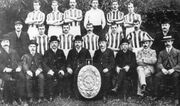
1904-05 Southern League winning team
Another landmark was reached during 1904-05 when Jack Lewis was called up to the Welsh national team, becoming the first Bristol Rovers player to receive an international cap while still at the club. 1904-05 was a successful campaign for Rovers, the season providing the first league title and third Gloucestershire Cup for the club.
Honours
- Southern League Division 1 - 1904-05
- Gloucestershire Cup - 1902-03 and 1904-05
The 1910s[]
| Season | League | Position |
|---|---|---|
| 1909-10 | Southern League Division 1 | 13th of 22 |
| 1910-11 | Southern League Division 1 | 16th of 20 |
| 1911-12 | Southern League Division 1 | 17th of 20 |
| 1912-13 | Southern League Division 1 | 16th of 20 |
| 1913-14 | Southern League Division 1 | 17th of 20 |
| 1914-15 | Southern League Division 1 | 16th of 20 |
Only six league seasons were played during this decade due to World War I. 1909-10 marked the beginning of a disappointing run of league performances, with the team never finishing better than 13th in the Southern League in the six seasons before the war. During the 1909-10 FA Cup campaign Rovers were drawn at home to Barnsley after having previously beaten Grimsby Town, but Barnsley offered Rovers £500 to switch the tie to Oakwell where the Yorkshire club won 4-0. On 27 April 1910, in a match against New Brompton (now known as Gillingham), Fred Corbett scored his 50th Southern League goal for Rovers, becoming the only player to score 50 goals in the Southern League for the club.
Although one season of league football was played after the outbreak of war, the 1914-15 would be the last season of competitive football played by Rovers until 1919.
Honours
- Gloucestershire Cup - 1913-14
The 1920s[]
| Season | League | Position |
|---|---|---|
| 1919-20 | Southern League | 17th of 22 |
| 1920-21 | Football League Division 3 | 10th of 22 |
| 1921-22 | Football League Division 3 (South) | 14th of 22 |
| 1922-23 | Football League Division 3 (South) | 13th of 22 |
| 1923-24 | Football League Division 3 (South) | 9th of 22 |
| 1924-25 | Football League Division 3 (South) | 17th of 22 |
| 1925-26 | Football League Division 3 (South) | 19th of 22 |
| 1926-27 | Football League Division 3 (South) | 10th of 22 |
| 1927-28 | Football League Division 3 (South) | 19th of 22 |
| 1928-29 | Football League Division 3 (South) | 19th of 22 |

Bristol Rovers team kit for the 1920-21 season. Copyright Historical Football Kits and reproduced by kind permission.
On 18 May 1920 a meeting was held between representatives of the Southern League and The Football League and it was decided to move all of the Southern League teams into the new third division of the Football League, which up to this point had consisted of two divisions. As a result Rovers lined up against Millwall on 28 August 1920 for their first match as a football league side, which they lost 2-0. This season also saw Rovers change their team colours from the black and white stripes that had been used since 1899 to white jerseys with blue shorts.
The first Rovers player to be sent off in the Football League was Bill Panes, who was expelled on 4 February 1922 during a game with Luton Town at Eastville.
Attendances were high during this period. On several occasions during this decade, matches between the two Bristol clubs attracted crowds of 30,000 spectators. Even reserve team matches were well attended; a Southern League game against Bristol City played in April 1923 at Ashton Gate attracted 7,000 fans.
In September 1922, an Egyptian engineering student at the University of Bristol called Mahmoud Mokhtar El-Tetsh had an unsuccessful trial during a reserve game with Bristol Rovers. Although he didn't earn a professional contract in Bristol, or at Tranmere Rovers where he also had a trial, he went on to become a six-time winner of the Egyptian player of the year award and the Egyptian national stadium was named after him.
Another noteworthy player to appear for Rovers in this decade was Ronnie Dix (born 5 September 1912). He made his debut on 25 February 1928 against Charlton Athletic at an age of 15 years, 173 days, making him the youngest player to represent Bristol Rovers in a competitive first-team match. One week later, in a game against Norwich City on 3 March 1928 he scored his first goal at an age of 15 Years, 180 days, making him the youngest goalscorer in Football League history, a record that still stands today. He remained the only 15-year-old to play for Rovers for almost 77 years, when Scott Sinclair made his debut aged 15 years, 275 days in December 2004.
Honours
- Gloucestershire Cup - 1924-25 and 1927-28
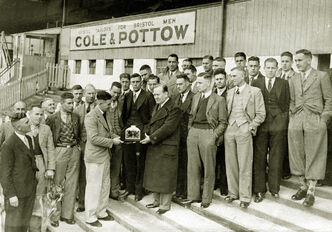
Albert Prince Cox
The 1930s[]
| Season | League | Position |
|---|---|---|
| 1929-30 | Football League Division 3 (South) | 20th of 22 |
| 1930-31 | Football League Division 3 (South) | 15th of 22 |
| 1931-32 | Football League Division 3 (South) | 18th of 22 |
| 1932-33 | Football League Division 3 (South) | 9th of 22 |
| 1933-34 | Football League Division 3 (South) | 7th of 22 |
| 1934-35 | Football League Division 3 (South) | 8th of 22 |
| 1935-36 | Football League Division 3 (South) | 17th of 22 |
| 1936-37 | Football League Division 3 (South) | 15th of 22 |
| 1937-38 | Football League Division 3 (South) | 15th of 22 |
| 1938-39 | Football League Division 3 (South) | 22nd of 22 |
Bristol Rovers' manager David McLean resigned on 17 September 1930. His replacement, Captain Albert Prince-Cox brought many changes to the club. One of his first actions as manager was to take the club on a mid-season tour of The Netherlands, and on 16 November 1930 Rovers beat the Dutch national team 3-2, just 24 hours after beating Coventry City 1-0 in the league.

Bristol Rovers team kit for the 1930-31 season. Copyright Historical Football Kits and reproduced by kind permission.

Bristol Rovers team kit for the 1931-32 season. Copyright Historical Football Kits and reproduced by kind permission.
One of the innovations introduced by Albert Prince-Cox was the blue and white quartered shirts, which are still worn today. These were first used during the 1931-32 season, Prince-Cox believed that they made the players look larger and more intimidating.
During the 1931-32 season, the team took part in two mid-season tours of The Netherlands, and one of France. The team also returned to France at the end of the season where they played AC Milan and a French XI, losing both games 3-1.
The sequence of events that eventually resulted in Bristol Rovers leaving the city and playing their home games in Bath during the 1980s began in 1932, when Rovers agreed a lease of Eastville Stadium to the Bristol Greyhound Racing Association that included a clause stating that if Rovers were to sell the stadium then the greyhound association would have first refusal, and that the price would not exceed £13,000. In 1934 the lease was amended to allow the Bristol Greyhound Racing Association to buy the stadium whenever they wished to purchase it, providing that they gave two months notice in writing to the football club. The purchase price was guaranteed to be not less than £8,000 and not more than £13,000. In 1939, Rovers wrote to the greyhound company informing them that they were prepared to sell the stadium, the greyhound company replying with an offer of £20,000 for the freehold.
On 13 April 1935, Rovers played Watford in the final of the Division 3 (South) Cup at The Den. The match was played at a neutral venue because both clubs had refused to take part in a coin toss to decide home advantage. Rovers won the match 3-2, winning their only national trophy in the period between World War I and World War II.
During a match with Luton Town on 13 April 1936, Rovers suffered the biggest defeat in their history, losing 12-0. 10 of the goals were scored by Joe Payne, which is still the league record for the most goals scored by a single player in a match. Rovers finished bottom of the league in the 1938-39 season, and were forced to apply for re-election to the league when competitive football resumed after the war.
Honours
- Division 3 (South) Cup - 1934-35
- Gloucestershire Cup - 1934-35, 1935-36 and 1937-38
The 1940s[]
| Season | League | Position |
|---|---|---|
| 1946-47 | Football League Division 3 (South) | 14th of 22 |
| 1947-48 | Football League Division 3 (South) | 20th of 22 |
| 1948-49 | Football League Division 3 (South) | 5th of 22 |
Official league football resumed after World War II for the 1946-47 season. During the war Rovers had played mainly friendly games, and also took part in the unofficial Division 3 South (South) competition in 1945-46.
The Bristol Rovers Supporters Club was set up in 1947 to provide financial support to the football club. The first chairman was former Gloucestershire cricketer Herbert Alpass.
Honours
- Gloucestershire Cup - 1947-48 and 1948-49
The 1950s[]
| Season | League | Position |
|---|---|---|
| 1949-50 | Football League Division 3 (South) | 9th of 22 |
| 1950-51 | Football League Division 3 (South) | 6th of 24 |
| 1951-52 | Football League Division 3 (South) | 7th of 24 |
| 1952-53 | Football League Division 3 (South) | 1st of 24 |
| 1953-54 | Football League Division 2 | 9th of 22 |
| 1954-55 | Football League Division 2 | 9th of 22 |
| 1955-56 | Football League Division 2 | 6th of 22 |
| 1956-57 | Football League Division 2 | 9th of 22 |
| 1957-58 | Football League Division 2 | 10th of 22 |
| 1958-59 | Football League Division 2 | 6th of 22 |
The 1950s was the most successful decade in the history of Bristol Rovers. The club reached the quarter-finals of the FA Cup twice, achieved their highest ever placing in the football pyramid, won a divisional title and had a player called up to the England squad. Geoff Bradford won his first and only international cap for England in 1955, when he played, and scored, in a 5-1 win over Denmark. This was the only time a Bristol Rovers player has ever played for England while at the club.
During the second world war, the Bristol Greyhound Racing Association had invested money into Bristol Rovers, and as a result the Greyhound Association had taken control of the football club's accounts and board of directors. In 1950, an FA commission, after examining the club's books, fined Bristol Rovers £250 and ordered the greyhound company to relinquish its controlling interest in the football club and banned club secretary Charles Ferrari from football club management.
In the 1950-51 season Bristol Rovers reached the quarter-finals of the FA Cup for the first time. The quarter-final was against Newcastle United at St James' Park and was a 0-0 draw. The attendance at this game was 62,787, and it remains the largest ever crowd to watch a match involving Bristol Rovers. The replay at Eastville attracted an attendance of 30,074 to see Newcastle win 3-1. This season also saw the adoption of Goodnight, Irene as a favorite song of Bristol Rovers fans. The song was sung at the Rovers fans by supporters of Plymouth Argyle before a match at Eastville, because a version of it was in the charts at the time, and again to taunt the Rovers fans after Argyle had taken the lead. Rovers went on to win the game 3-1 and replied to the Plymouth taunts by singing Goodnight Argyle. The song remained popular with the Rovers fans, and over the years became the anthem of the supporters.
The first league title to be won by Bristol Rovers since the 1904-05 Southern League championship was the 1952-53 Division 3 (South) title. This was the first time Rovers had won promotion since joining the Football League in 1920.
The highest ever league placing by Rovers was achieved in both the 1955-56 and 1958-59 seasons, when the team finished in sixth place in the second tier of league football. In 1955-56, Rovers only missed out on promotion to the top flight by four points.
Perhaps the most impressive win in the history of Bristol Rovers was the 4-0 FA Cup victory over Manchester United, managed by Matt Busby, on 7 January 1956. Five of the United players on that day were later to die in the Munich air disaster. In the same competition during the 1957-58 season Rovers reached the quarter-final for the second time, where they lost 3-1 to Fulham at Craven Cottage.
Honours
- Football League Division 3 (South) - 1952-53
- Gloucestershire Cup
- Won - 1954-55 and 1955-56
- Drew - 1950-51, 1953-54 and 1958-59
The 1960s[]
| Season | League | Position |
|---|---|---|
| 1959-60 | Football League Division 2 | 9th of 22 |
| 1960-61 | Football League Division 2 | 17th of 22 |
| 1961-62 | Football League Division 2 | 21st of 22 |
| 1962-63 | Football League Division 3 | 19th of 24 |
| 1963-64 | Football League Division 3 | 12th of 24 |
| 1964-65 | Football League Division 3 | 6th of 24 |
| 1965-66 | Football League Division 3 | 16th of 24 |
| 1966-67 | Football League Division 3 | 5th of 24 |
| 1967-68 | Football League Division 3 | 16th of 24 |
| 1968-69 | Football League Division 3 | 16th of 24 |
The biggest comeback in the history of Bristol Rovers came on 29 August 1960, when Rovers trailed Leeds United 4-0 at half time at Eastville. Rovers then scored four goals in the second half, resulting in a 4-4 draw.
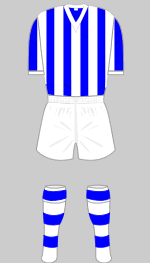
Bristol Rovers team kit for the 1963-64 season. Copyright Historical Football Kits and reproduced by kind permission.
The 1960-61 season was the debut of the League Cup, and Rovers are credited with being the first winners of a game in this competition. On 26 September 1960, Rovers beat Fulham 2-1 at Eastville in front of a crowd of 20,022. Although other first round games were played on the same evening, the Rovers v Fulham game kicked off early at 7:15pm, meaning that this was the first result in the competition.
For the 1962-63 season, Rovers abandoned their now familiar blue and white quarters in favour of blue pinstripes. Also in this season, the club signed goalkeeper Esmond Million from Middlesbrough for £5,000. In April 1963, The People newspaper ran a story alleging that Million had accepted a bribe to lose the match against Bradford (Park Avenue) on 20 April. During the game he had allowed a backpass to slip past him and allowed a cross to go, enabling Bradford to score twice. Unfortunately for Million, Rovers also scored twice so the game ended 2-2 and Million did not receive the money he had been offered to lose the game. Million and his accomplice, Keith Williams, were fined £50 each by Doncaster Magistrates' Court, and banned from football for life by The FA.
On 14 December 1963, during a 4-0 victory over Bristol City, Geoff Bradford scored his final goal for Bristol Rovers. This was his 242nd league goal for the club, which still stands as a club record, and he scored a total of 355 goals for the club in all competitions and reserve team games.
Honours
- Gloucesterhsire Cup
- Won - 1962-63, 1964-65 and 1965-66
- Shared - 1963-64 and 1967-68
The 1970s[]
| Season | League | Position |
|---|---|---|
| 1969-70 | Football League Division 3 | 3rd of 24 |
| 1970-71 | Football League Division 3 | 6th of 24 |
| 1971-72 | Football League Division 3 | 6th of 24 |
| 1972-73 | Football League Division 3 | 5th of 24 |
| 1973-74 | Football League Division 3 | 2nd of 24 |
| 1974-75 | Football League Division 2 | 19th of 22 |
| 1975-76 | Football League Division 2 | 18th of 22 |
| 1976-77 | Football League Division 2 | 15th of 22 |
| 1977-78 | Football League Division 2 | 18th of 22 |
| 1978-79 | Football League Division 2 | 16th of 22 |

Bristol Rovers team kit for the 1972-73 season. Copyright Historical Football Kits and reproduced by kind permission.
The furthest Bristol Rovers have ever progressed in the league cup is the quarter-finals. This was achieved twice in consecutive seasons - 1970-71 and 1971-72. On the first occasion, Rovers lost their quarter-final match against Aston Villa 1-0 in a replay at Villa Park, having drawn 1-1 at Eastville. The following season they lost 4-2 at home to Stoke City, infront of a crowd of 33,624 at the same stage of the competition.
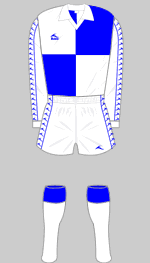
Bristol Rovers team kit for the 1978-79 season. Copyright Historical Football Kits and reproduced by kind permission.
In July 1972, Rovers appointed Don Megson as their new manager. His first task as manager was to guide the team through the Watney Cup, where the team beat Wolves and Burnley to reach the final of the competition at Eastville. On 5 August 1972, Rovers faced Sheffield United in the final in a match that was drawn 0-0 at full time. A penalty shoot-out was held to decide the winners, and Rovers won 7-6, meaning that Megson had won a trophy after only three matches as manager. Also that season, Rovers made good progress in the League Cup. In the third round they played a Manchester United side that included Bobby Charlton and George Best and drew 1-1 at Eastville, earning a replay at Old Trafford. Rovers won the replay 2-1 and progressed to play Wolves in the fourth round, but failed to make it to a third consecutive quarter-final after losing 4-0.
For the 1973-74 season, Rovers had switched back to their blue and white quartered shirts, which they have worn ever since. This coincided with a promotion-winning season, with second place in division 3 earning them a second spell in the second division. On their way to promotion, the team won 8-2 away to Brighton & Hove Albion, managed by Brian Clough, the only 8-2 away win ever recorded in the third division. This was also the only league game where two Bristol Rovers players scored hat-tricks in the same match, with Alan Warboys scoring 4 and Bruce Bannister 3.
Rovers' heaviest post-war league defeat came during the 1977-78 season, when they lost 9-0 to Tottenham Hotspur at White Hart Lane. Shortly after this result, manager Don Megson left the club to join the Portland Timbers in the NASL.
On 24 October 1978, Rovers played a friendly against the Zambian national team at Eastville, where the touring side were beaten 4-1.
Honours
- Watney Cup - 1972-73
- Gloucestershire Cup - 1973-74 and 1974-75
The 1980s[]
| Season | League | Position |
|---|---|---|
| 1979-80 | Football League Division 2 | 19th of 22 |
| 1980-81 | Football League Division 2 | 22nd of 22 |
| 1981-82 | Football League Division 3 | 15th of 24 |
| 1982-83 | Football League Division 3 | 7th of 24 |
| 1983-84 | Canon League Division 3 | 5th of 24 |
| 1984-85 | Canon League Division 3 | 6th of 24 |
| 1985-86 | Canon League Division 3 | 16th of 24 |
| 1986-87 | Today League Division 3 | 19th of 24 |
| 1987-88 | Barclays League Division 3 | 8th of 24 |
| 1988-89 | Barclays League Division 3 | 5th of 24 |
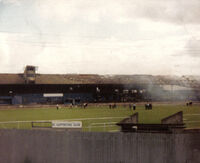
Aftermath of the South Stand fire at Eastville, August 1980

The club badge used during the 80s and early 90s
The 1980-81 season was probably the worst in the club's history. Rovers won just five league games during the season, and only four home wins in all competitions. The team was relegated at the end of the season, finishing in last place, seven points below the other relegated team, Bristol City. The club had also failed to agree an extension to the lease on their stadium, which had had its capacity reduced from 30,000 to 12,500 due to new safety laws, causing fears that they would have to find a new home. On 17 August 1980, a fire started in the South Grandstand in Eastville Stadium, destroying the administrative offices and changing rooms. As a result, Rovers were forced to play five games at Ashton Gate, three in the league and two in the League Cup. This location was not popular with the fans however, who considered this to be enemy territory, and all five games were poorly attended.
During the 1981-82 season, with the lease on Eastville coming to an end, Rovers were offered deals to groundshare by both Bristol City and Bath City, however a five-year extension to their existing lease was agreed and Rovers would remain at Eastville until 1986. Before the lease was agreed, the Rovers chairman, Martin Flook, had made an offer of £450,000 to buy Ashton Gate Stadium from Bristol City, who were on the verge of bankruptcy at the time. However, when City reformed as Bristol City (1982) plc, this bid was rejected.
The only World Cup winner to play for Bristol Rovers was Alan Ball, who won the tournament with England in 1966. He signed for the club in January 1983 and made 17 league appearances, scoring two goals, in what would be his final season before retiring as a player.
The last game to be played at Eastville was on 26 April 1986, when Rovers drew 1-1 with Chesterfield infront of just 3,576 spectators. The following season Rovers moved to Bath City's Twerton Park ground, where they would remain for ten years. One home game during the first season in Bath was played at Ashton Gate however, the match against Swindon Town was played infront of 8,196 spectators in an effort to raise money to help with Rovers' financial problems.
At the start of the 1987-88 season, former Rovers player Gerry Francis was appointed as manager. He immediately went about building the team that would go on to win the league in two years time, signing Nigel Martyn, Ian Holloway and Devon White before the start of his first season in charge. The following season, 1988-89, Rovers reached the third division play-off final for the first time, but they failed to win promotion, losing by a single goal to Port Vale.
Honours
- Gloucestershire Cup - 1981-82, 1982-83, 1983-84, 1984-85 and 1988-89
The 1990s[]
| Season | League | Position |
|---|---|---|
| 1989-90 | Barclays League Division 3 | 1st of 24 |
| 1990-91 | Barclays League Division 2 | 13th of 24 |
| 1991-92 | Barclays League Division 2 | 13th of 24 |
| 1992-93 | Barclays League Division 1 | 24th of 24 |
| 1993-94 | Endsleigh League Division 2 | 8th of 24 |
| 1994-95 | Endsleigh League Division 2 | 4th of 24 |
| 1995-96 | Endsleigh League Division 2 | 10th of 24 |
| 1996-97 | Nationwide Football League Division 2 | 17th of 24 |
| 1997-98 | Nationwide Football League Division 2 | 5th of 24 |
| 1998-99 | Nationwide Football League Division 2 | 13th of 24 |
Success in the league was achieved by Gerry Francis in his third season as Bristol Rovers manager. The team won the 1989-90 third division championship, clinching the title on 2 May 1990 with a 3-0 victory over local rivals Bristol City, who finished second and were also promoted. This match inspired the title of a former Bristol Rovers fanzine, The Second of May. The championship winning season was rounded off by the club's first ever appearance at Wembley Stadium, where they lost 2-1 to Tranmere Rovers in the final of the Leyland DAF Cup. 32,000 Rovers fans travelled to Wembley for the match, which was also attended by cult band (and Tranmere fans) Half Man Half Biscuit, who later performed Goodnight Irene on John Peel's radio show as a tribute to the Bristol Rovers fans on that day.
The following season Rovers suffered a second fire at their ground. Ten years after the fire at Eastville, the main stand at Twerton Park was damaged on 16 September 1990 in what was later found to be an arson attack. Seven Bristol City fans were later tried and convicted of the crime.
Rovers' third season in the second tier of the league resulted in relegation. At the end of the 1992-93 season, Rovers were bottom of the division, now known as Division One due to the creation of the FA Premier League. The club made their most expensive signing ever during this season, buying Andy Tillson from QPR for £370,000.
A second appearance at Wembley was earned at the end of the 1994-95 season, in the Second Division play-off final. Rovers lost by the same scoreline as their previous game to be played there - 2-1. This time the opponents were Huddersfield Town, and the attendance of 59,175 is the third highest ever at a Bristol Rovers game. Also during this season, Rovers faced their landlords, Bath City, in the first round of the FA Cup. Rovers won the game 5-0, and unusually for a game involving a league team, there was no fan segregation in the ground.
Rovers' return to Bristol was at the beginning of the 1996-97 season. Bristol Rugby Club were experiencing financial difficulties, and offered Rovers the opportunity to buy half of the Memorial Ground (now called The Memorial Stadium) for £2.3 million. The stadium was not ready for league football however, and the first game of the season was played at Twerton Park. The return to Bristol was finally achieved for the second home game of the season against Stockport County, a game that was drawn 1-1. The Bristol Rovers home kit for this season featured an unusual striped quartered design, known to the club's fans as the Tesco bag shirts in reference to the company's blue and white striped carrier bags. This design was not universally popular, and prompted the Trumpton Times fanzine to change its name to Wot, No Quarters?.
On 17 April 1998, Bristol Rugby Club were placed in receivership, invoking a clause in the tenancy agreement allowing Rovers to buy the other half of the Memorial Ground for £100,000. Rovers now owned their own stadium for the first time since 1939.
Honours
- Barclays League Division 3 - 1989-90
- Gloucestershire Cup - 1989-90, 1992-93, 1993-94 and 1994-95
The 2000s[]
| Season | League | Position |
|---|---|---|
| 1999-2000 | Nationwide Football League Division 2 | 7th of 24 |
| 2000-01 | Nationwide Football League Division 2 | 21st of 24 |
| 2001-02 | Nationwide Football League Division 3 | 23rd of 24 |
| 2002-03 | Nationwide Football League Division 3 | 20th of 24 |
| 2003-04 | Nationwide Football League Division 3 | 15th of 24 |
| 2004-05 | Coca-Cola Football League 2 | 12th of 24 |
| 2005-06 | Coca-Cola Football League 2 | 12th of 24 |
| 2006-07 | Coca-Cola Football League 2 | 6th of 24 |
| 2007-08 | Coca-Cola Football League 1 | 16th of 24 |
Until the end of the 2000-01 season, Bristol Rovers were the only team in the Football League never to have played in the first or the fourth levels of the league. This record ended when the team were relegated to Division 3 for the 2001-02 season. Gerry Francis returned to the club and oversaw a good start that saw them top the division at the end of August; results soon faded however, and it became clear that Rovers were not going to get out of the division at the first attempt. Francis resigned due to personal issues in December with the side in 20th place, and Garry Thompson took over. Despite masterminding a cup upset against Premier League opponents Derby County, Rovers' League form remained poor, and the club hit its lowest ebb, finishing second bottom of the whole League and only surviving due to a truly awful season by bottom-placed Halifax Town.

Bristol Rovers team kit for the 2007-08 season. Copyright Historical Football Kits and reproduced by kind permission.
With the League introducing two relegation places from Division Three the next season it was obvious that Rovers would have to improve quickly, and Thompson was duly sacked and replaced by former player Ray Graydon. While Graydon had experienced promotion success twice with Walsall, he failed to significantly improve Rovers' form, and the next two seasons were also spent fighting relegation to the Conference. Soon, Graydon was gone, and Ian Atkins took the hotseat. A slight improvement resulted, resulting in Rovers hovering in mid-table; this was far from what the board and fans wanted however, and after just over a season in charge Atkins was dismissed, and in his place the club appointed Paul Trollope as first-team coach, aided by director of football Lennie Lawrence. Trollope's first season saw the club briefly contend for the play-offs, but resulted in another mid-table finish.
During the 2006-07 season, Rovers reached the final of the Football League Trophy for the second time. The team were beaten 3-2 by Doncaster Rovers after extra time, having drawn 2-2 after 90 minutes at the Millennium Stadium in Cardiff. They also qualified for the playoffs, and after beating Lincoln City 7-2 on aggregate Rovers qualified for the final at the new Wembley Stadium. In the final they faced Shrewsbury Town in front of 61,589 spectators (the second highest attendance at a Rovers game), Bristol Rovers won by three goals to one, and became only the second team, after Chelsea, to have played at both Millennium Stadium and Wembley Stadium in the same season.
Honours
- League Two Play-Off winners - 2006-07
Source[]
| This page uses Creative Commons Licensed content from Wikipedia (view authors). | 
|
References[]
- Byrne, Stephen & Jay, Mike (2003): Bristol Rovers Football Club, The Definitive History 1883-2003. ISBN 0-7524-2717-2
- Rollin, Glenda & Rollin, Jack (2006): Sky Sports Football Yearbook 2006-2007. ISBN 0-7553-1526-X
- The early days to the present day from bristolrovers.co.uk. Retrieved 25 October 2006.
- Dates and honours from bristolrovers.co.uk. Retrieved 25 October 2006.
- Geoff Bradford from bristolrovers.co.uk. Retrieved 5 November 2006.
- Bristol Rovers from Soccerbase. Retrieved 28 October 2006.
- Denmark 1-5 England, 2 October 1955 from thefa.com. Retrieved 4 November 2006.
- Goodnight Irene, by Half Man Half Biscuit from hmhb.co.uk. Retrieved 7 November 2006.